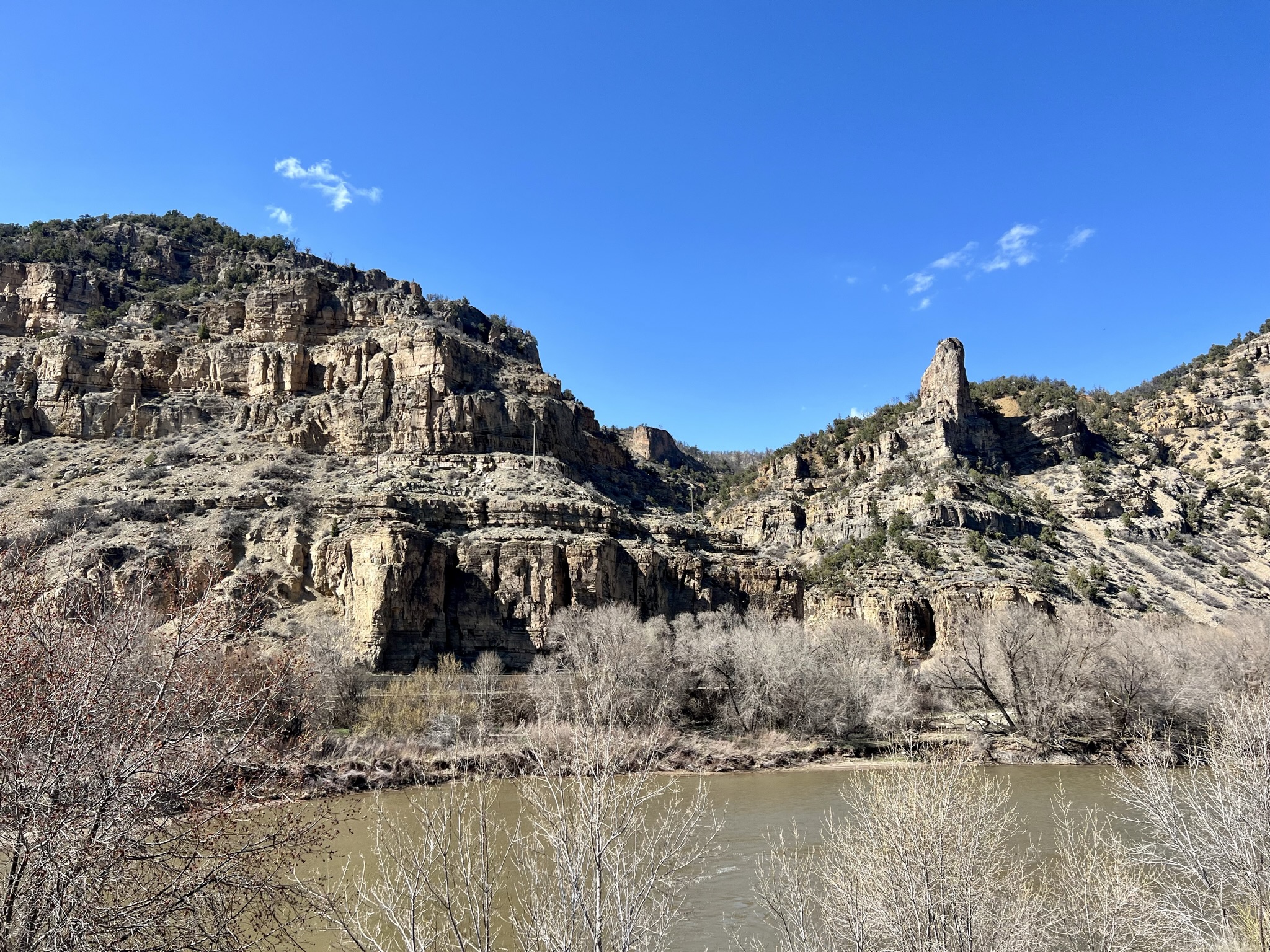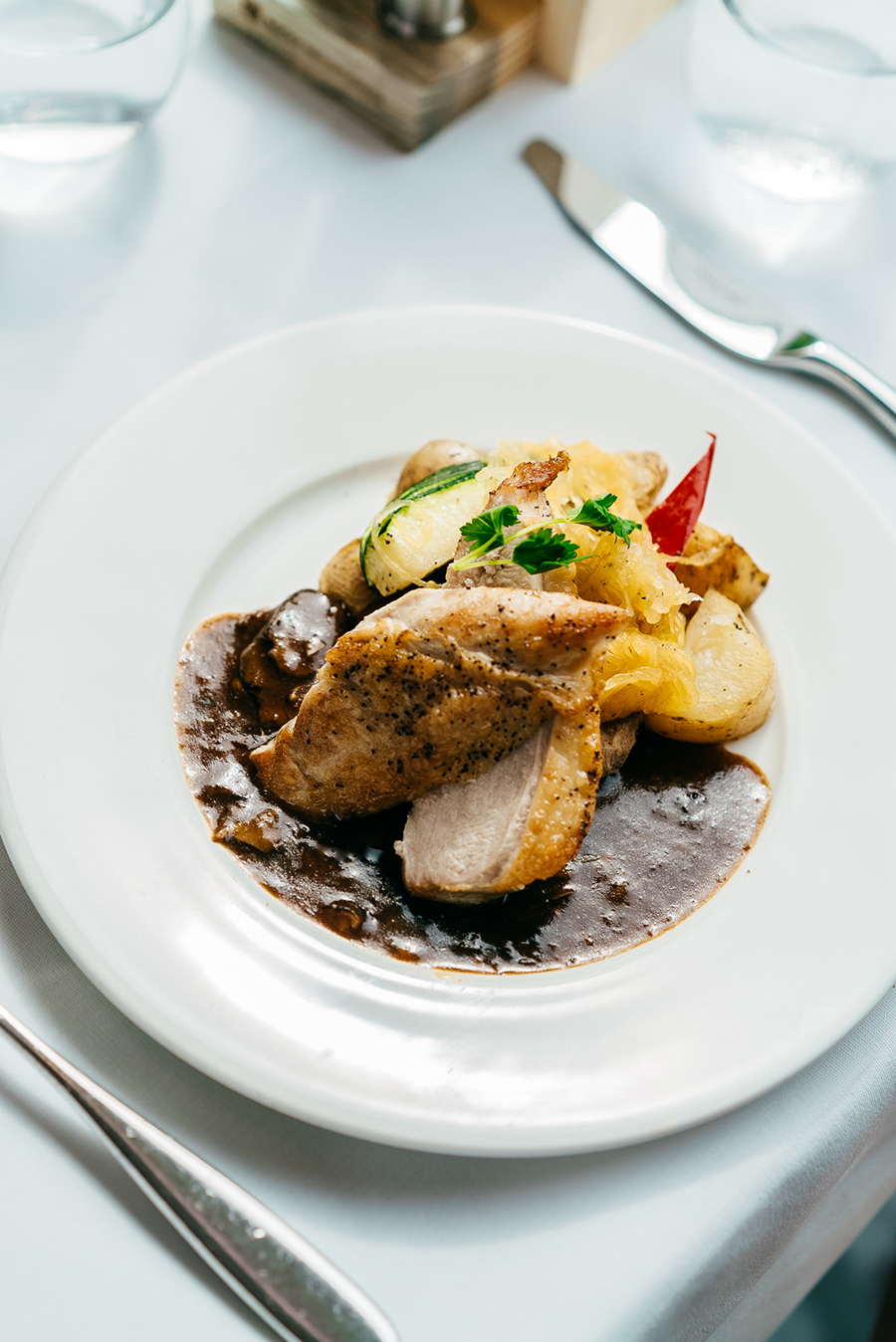From the Rockies to Red Rocks: Taking the Train From Colorado to Utah

Exterior of Rocky Mountaineer train near Ruby Canyon, Utah. Photo: Courtesy of Rocky Mountaineer
The Canadian rail tour company Rocky Mountaineer has been running a U.S. trip for a couple of years now. It goes between Denver, Co., and Moab, Utah, and is called the Rockies to Red Rocks tour.
It’s a catchy phrase. But it only captures a sliver of what I saw on my recent two-day trek.
Our train pulled out of Denver on a Sunday morning in April and quickly began to climb into the Rocky Mountains. The soft, rounded mountains were covered with black-brown rock and deep green fir trees, made all the more striking by a thin blanket of fresh, pure white snow that had fallen the day before.
We chugged past winter ski resorts and were greeted by a pair of teenagers who regularly come out to wave at the passing Mountaineer as it flies past their nearby homes.
We also wound our way through the 10-kilometre (six-mile) long Moffat Tunnel. We were told the average train trip through this part of the Rockies took five hours before the tunnel was built, and that riders on one unlucky train once took 60 days to traverse the mountain pass. (How they got food, I don’t know.) With the Moffat Tunnel, we breezed through in a mere 12 minutes.

As we went further west, the scenery began to change. The banks of the Colorado River were lined with beautiful, wispy reeds the colour of summer wheat. Pine trees began to give way to chaparral, causing a writer of a certain age to quietly croon the old western classic “Tumbling Tumbleweeds.”
The train soon entered Byers Canyon, the first of many steep, awe-inspiring mountain cracks the train traverses between Colorado and Utah. Naturally, as Byers is my surname, I got a kick out of this. I also learned that William Byers, for whom the canyon is named, founded the Rocky Mountain News in Denver in 1859, the first daily newspaper in Colorado.

As I peered out of one of the vantage cars, which offer open views to the passing scenery, I could see a massive brown-black cliff rising above the side of the train, seemingly poised to topple at any moment. Quaking aspen trees covered with white bark gathered along the banks of the Colorado River, here a mere whisper of a thing compared to what comes further west.
Eventually, the landscape flattened, with the view revealing wide plains with distant, white-capped mountains. The river was wider here, and fishing boats and whitewater rafts began to appear. (So did some mysterious, whitish, round objects, as rafters in particular seem fond of mooning passing trains.)
The unexpected R-rated show aside, passengers oohed and aahed as the landscape began to change. The grey, brown and black-streaked rocks we had seen earlier began to turn a brilliant shade of burnt orange. We passed sandstone cliffs with layers of orange, white and camel-coloured rock, all mixed up like a bowl of ice cream put in a whirling blender.
Cattle grazed off to one side of the train on a dun-coloured field as we passed mule deer and modest, creekside homes. The cliffs turned from orange to pale brown and back to orange, with striations and wavy lines that sloped up and down, remnants of long-ago tectonic shifts.
We passed wide-open ranches, one of which is said to be owned by the Paul Newman foundation and takes underprivileged city kids out into the country for a few days at a time. I also passed a property, perhaps a little down on its luck, with the name “Rancho Starvo.”

Glenwood Canyon was particularly astonishing, a powerful ridge of mountains sliced by the icy Colorado River. Our train skittered along the tracks, with grey-brown, rugged rock-strewn walls towering over us on the both sides.
We stopped for the night in the attractive, fun town of Glenwood Springs, a former wild west town that has hosted the likes of Buffalo Bill Cody, Al Capone and Doc Holliday, the famous O.K. Corral gunslinger. Holliday is buried in the Pioneer Cemetery in Glenwood Springs, which also is home to a lovely hot springs.

As we rolled further into western Colorado the next day, the brilliant pink blossoms of spring cherry trees appeared in fields on our right. We then sprinted into Utah, passing more rugged rock formations and bluffs and buttes in impossible, iron-stained shades of orange and red.
Finally, as we neared Moab, the earth revealed a series of small hills covered by blue-green rock, which our guide explained was iron that hadn’t been fully oxidized. Astonishing.
As great as the scenery is on a Rocky Mountaineer tour, one of the best things they offer is a map of key sites (and rail-side mileage marker information) along the way, which makes it easy to find landmarks. Better still are the stories told by the engaging, on-board guides.
Outside of Parachute, Co., our main guide, a friendly, lanky fellow named August Bont, told us that a local settler named Mike Callahan came to the region and started collecting black stone for his fireplace. Local Native Americans warned him against the idea, but Callahan thought a bright, orange flame would look nice against the black rock and went ahead.
He finished his stone work one day, tossed a log on the fire and lit a match. Shortly afterward came a booming explosion that nearly killed Callahan. Turns out the rock was black because it was riddled with oil, which the natives knew would not act in harmony with a burning fire.
A big train robbery took place in western Colorado in June of 1907, Bont told us. The guilty bandit, Harry Logan, retreated into some difficult terrain, but the local sheriff was able to track him down.
“You might ask how he managed it,” August told us. “Turns out the sheriff had a 1907 mustang.”
Ba da boom. It was a corny joke, but Bont was beaming such a broad smile and barely stifling a giggle, so I had to laugh along with him.

The Rocky Mountaineer train cars are lovely. In SilverLeaf class the windows reach way up to the top of the car and provide panoramic views. There was a piano in the bar lounge, which someone played briefly (and quite well) one day, as well as a Scrabble game and playing cards. The seats in the bar car were soft and luxurious, and some people made it their full-time home so they could really stretch out. Okay, and drink a little.
Alan, a first-time Mountaineer guest from Adelaide, Australia, said the scenery was terrific, and that the guides told great stories.
“The service is exceptional,” said his wife, Vanessa. “The staff is really engaged.”
“It’s absolutely beautiful,” said Jean Miller of Red Deer, Alta.. “I would say service is the No. 1 thing. The food is No. 2, and the scenery is three.”
“For me the scenery is the best thing,” said Catherine Burbridge also of Red Deer. “We live in Alberta. It’s beautiful, but this is different.”

“It’s just lovely,” said Shannon Keever of Las Vegas. “My stepfather just got out of the hospital, so it’s wonderful to look at nature and sit and relax like this. You get first-class service hour after hour.
Keever said she’d like to see a bit more help for train passengers trying to get home from the small town of Moab. Her husband, Richard, suggested that the on-board commentary from the guides be piped into the lounge car so all passengers could hear.
Several guests singled out the food as one of the top attractions. Before we even pulled out of Denver we were presented with a fresh blueberry scone with strawberry jam and coffee at our seats. An hour or so later, came fresh fruit, waffles, a fluffy biscuit with sausage gravy, and bacon and eggs. The eggs were topped with grilled peppers and onions. Lunch (I promise you will not go hungry on the Mountaineer) included a choice of grilled chicken and beef short ribs.

The next day at breakfast my wife and I enjoyed an egg white frittata, fabulous cinnamon rolls backed in Glenwood Springs and terrific peach cobbler with Colorado peaches.
In some classes, all your drinks are included. We didn’t go crazy, but we did enjoy pretty good Colorado red wine and other offerings from California.
The bartender in the bar car, Cheryl, made an excellent margarita with good tequila, fresh lime juice (“It takes me a LONG time to squeeze all these limes”), simple syrup and Cointreau, with a salted rim.
I complimented her on her workmanship and she smiled.
“I wouldn’t serve anything that I wouldn’t drink myself,” she said with a grin.
Just the Facts
The Rocky Mountaineer in Canada offers GoldLeaf service, but limitations on trains in the American Rockies mean the highest level is SilverLeaf.
We travelled west from Denver to Moab, but you also can go east from Moab and finish your tour in Denver. They also have options that let you start or end your journey in Las Vegas or Salt Lake City.
Check the website for deals. The Mountaineer folks recently were offering savings of $780 per couple on Canadian routes or $1,000 per couple on the U.S. journey.
One great thing about Rocky Mountaineer is that they look after your transfers. Our bags were taken to the train in Denver and then delivered to our room in Glenwood Springs. The next morning, we left our bags in the room and someone gathered them up for us.
Before
We had a lovely one-day stay in Denver prior to our trip. We stayed the night at the Hotel Indigo, just a couple blocks from the city’s regal, old-time train station. We had a nice lunch at the upbeat Milk Market complex, a fun electric tuk tuk tour of the city with ETuk Ride Denver and a fabulous dinner at a restaurant called Citizen Rail.
During
Guests of the Rocky Mountaineer were put up at the Hotel Denver in Glenwood Springs. We had a handsome room with exposed brick walls and a view of the Colorado River and the surrounding valley. We had very good burgers and local craft beer a block away at Grind restaurant.
After
We had the full hotel package from Rocky Mountaineer, including a night in Moab at the end of our trip. They put us up at the smart, fashionable Hotel Hoodoo, a Curio Hilton hotel with a fine swimming pool and hot tub. We were only a block from a very good Thai restaurant named Thai Bella, and only 10 minutes from Arches National Park.
The Rockies to Red Rocks tour is a little shorter than Vancouver to Banff. Vancouver to Banff journeys finish in late afternoon in Alberta on your second day, whereas we pulled into Moab around 1 p.m. on Day 2.
RELATED:
Travel 2023: A Memorable Train Journey Through British Columbia and Alberta
Travel by the Book: 5 Classic Reads About Train Journeys
Travel 2023: Explore Ways to Nurture Your Health and Wellness